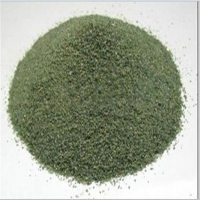

Overview of silicon carbide ceramics
Silicon carbide ceramic has high hardness, high melting point (2400℃), high wear resistance and corrosion resistance, as well as excellent oxidation resistance, high-temperature strength, chemical stability, thermal shock resistance, thermal conductivity and good aairtightness. Therefore, it has been widely used in energy, metallurgy, machinery, petroleum, chemical, aviation, aerospace, defense, and other fields. Black silicon carbide and green silicon carbide: The abrasive industry is customary to divide silicon carbide into black carbonized laurel and green silicon carbide according to their color. They are all hexagonal crystals and belong to α-SiC.
Black silicon carbide contains about 98.5% SiC. Black silicon carbide is made of quartz sand, petroleum coke and high-quality silica as the main raw materials, and is smelted in an electric furnace at high temperatures. Its hardness is between corundum and diamond, its mechanical strength is higher than corundum, and it is brittle and sharp. Its toughness is higher than that of green silicon carbide, and it is mainly used to process materials with low tensile strength, such as glass, ceramics, stone, refractory materials, cast iron and non-ferrous metals.
Green silicon carbide contains more than 99% SiC. Green silicon carbide is made of petroleum coke and high-quality silica. Salt is added as an additive and smelted in a high-temperature furnace. It is self-sharpening and is mainly used for processing cemented carbide, alloy and optical glass. It can also be used for wear-resistant cylinder liners and fine-grained high-speed steel tools.

Silicon carbide ceramic applications
The strong covalent bond of SiC is the root cause of a series of excellent properties of SiC ceramics, but it also brings difficulties to sintering. The covalent bond is too strong, hindering the sintering and densification of SiC ceramics. Therefore, the sintering temperature must be increased. , Which increases the cost and limits its application in the ndustry.
From the perspective of thermodynamics, the reduction of free energy caused by the agglomeration of the original powder during the sintering process is the main driving force for densification. However, the free energy of the grain boundary of SiC is relatively high, and even if it condenses from the solid-gas interface to the solid-solid interface, the free energy of the powder will decrease. The smaller the free energy difference, the smaller the driving force for the sintering process. Therefore, SiC powder is more difficult to sinter than other ceramics. The current commonly used method is to add a sintering aid to reduce the particle size of the original powder and pressurize. Change its free energy and promote the densification of SiC.

From the perspective of kinetics, the main mass transfer mechanisms in the sintering process are evaporation and condensation, viscous flow, surface diffusion, grain boundary or lattice diffusion, and plastic deformation. The strong covalent bond of SiC will reduce the solid-phase mass transfer rate, such as lattice diffusion and surface diffusion, while gas-phase mass transfer requires high temperatures to promote powder decomposition. The decomposition temperature of SiC is as high as 2500°C, so it is impossible to achieve ceramic densification by means of gas-phase mass transfer. Therefore, the existing sintering process mainly implements viscous flow by adding a sintering aid to increase the solid phase diffusion rate of SiC or to form a viscous liquid glass phase assisted SiC.
SiC ceramics have high purity, which can increase the thermal conductivity of SiC ceramics without producing other impurities. However, during the sintering process, a sintering aid must be introduced to reduce the sintering temperature and increase the density. How to solve the contradiction between the two is to sinter SiC ceramics with high thermal conductivity. Difficulties and priorities.
Al 2 O 3 ceramics have a relatively low sintering temperature, low cost, and good electrical insulation properties. They have been widely used, but their thermal conductivity is very low, and their application in high-power circuits is limited.
BeO ceramics have good dielectric properties and are used as high thermal conductivity substrate materials in some fields. However, due to the toxicity of BeO, Europe, the United States, Japan, and other places have begun to promulgate regulations restricting the sales and development of electronic products containing BeO.
AlN ceramics have excellent thermal and electrical insulation properties and low dielectric constant, making them suitable for high-power circuits. However, the sintering temperature of AlN ceramics is too high, resulting in a complicated preparation process and high cost, and it has not yet been mass-produced and applied. Moreover, AlN is prone to hydrolysis reaction, and its reliability is poor in humid environments.
SiC ceramic
low density, high mechanical strength, good oxidation resistance, wear resistance, excellent thermal shock resistance, small thermal expansion coefficient, and high thermal expansion coefficient matching the chip. They have the ability to resist chemical corrosion and have a good development in the field of electronic products. The future application prospects can meet the requirements of high performance, small size, lightweight, and high reliability of electronic equipment.
Silicon carbide ceramic price
The price of silicon carbide ceramics varies randomly with production costs, transportation costs, international conditions, exchange rates, and the supply and demand relationship of the silicon carbide ceramics market. Tanki New Materials Co. Ltd aims to help all industries and chemical wholesalers find high-quality, low-cost nanomaterials and chemicals by providing a full set of customized services. If you are looking for silicon carbide ceramic materials, please feel free to contact me to get the latest price of silicon carbide ceramics.
Silicon Carbide Ceramic Supplier
As a global supplier of silicon carbide ceramics, Tanki New Materials Co., Ltd. has extensive experience in the performance, application, and cost-effective manufacturing of advanced engineering materials. The company has successfully developed a series of powder materials (including oxides, carbides, nitrides, single metals, etc.), high-purity targets, functional ceramics, and structural devices, and provides OEM services.
If you are looking for high-quality silicon carbide ceramics Powder, please feel free to contact us and send an inquiry. ( sales@ozbo.com ).
Tanki New Materials Co.Ltd Aims to help All industries and Chemical Wholesalers to find high quality, cheap price nano materials and chemicals by providing turn-key customize manufacturing services.
As a trust-worthy
global nano-materials and chemicals manufacturer, Tanki New Materials Co.Ltd has been successfully supplying big and small brands with customized nano materials and chemical products in bulk or small quantities.
Tanki New
Materials Co.Ltd has rich experiences in the properties, applications, and cost-effective manufacturing of advanced and engineered materials. The company has successfully developed a series of powder materials (including oxides, carbides,
nitrides, single metal, etc.), high-purity targets, functional ceramics, and structural devices. OEM service is available.
Our innovative, high-performance materials are widely used in many industries, including but not limited
to the automotive, electrical, electronics, information technology, petrochemical, oil, ceramics, paint, metallurgy, solar energy, and catalysis.
Based in the center of China, the company has rich resources and chemical product
manufacuturing chains to make sure your cost remain as low as your specifications demand.
The company provides following products such as providing super high quality chemicals and Nano materials such as graphite powder,
boron powder , zinc sulfide , nitride powder, Calcium nitride, Ca3N2, 3D printing powder, and so on.

Ask a quote for the latest price and one of our team members will respond as soon as possible. Fields marked with * are required.
